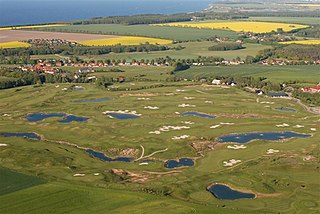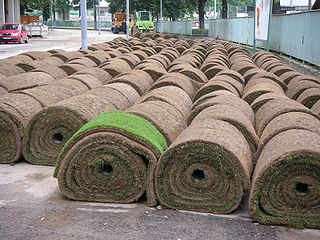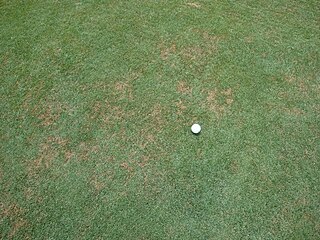A golf course superintendent is a person who professionally manages the labor, time, materials and financial resources needed to care for the turfgrass and landscaped grounds on a golf course. Golf course superintendents have also been referred to as greenskeepers and turf managers. Golf course superintendents are concerned with the environmental health of the golf course, the sporting needs of the players and the financial sustainability of the golf club or country club for which they work. Golf course superintendents communicate the status of the grounds and maintenance resources to members of the club’s management, owners or board of directors, green chairs and committees, golfers, vendors, suppliers, golf professionals, golf course architects and others in the golf industry.
Golf course superintendents monitor the natural weather patterns, environment and other influences that affect the playing areas and landscapes with which golfers interact. Golf course superintendents monitor the health of the golf course environment through study, diagnosis, and treatment of disease and injury to the golf course’s turfgrass fairways, tees and greens areas, as well as bunkers, areas of water hazard, naturalized areas and trees. Their management of the course is accomplished through a knowledge of biology, chemistry, plant pathology, and entomology. In the United States, golf course superintendents can be certified by the Golf Course Superintendents Association of America (GCSAA).

Fusarium patch is a disease in turf grass settings also called pink snow mold or Microdochium patch. In many cool season grass species in North America, it is caused by the fungus Microdochium nivale. The white-pink mycelium on infected leaf blades is a distinguishing characteristic of the Microdochium nivale pathogen. Fusarium patch is considered economically important in the turf grass industry because of its tendency to cause significant injury to golf greens, thereby decreasing putting surface quality. Dissimilar from other snow molds, such as gray snow mold, Microdochium nivale does not need snow cover to cause widespread infection.

A golf course is the grounds on which the sport of golf is played. It consists of a series of holes, each consisting of a tee box, a fairway, the rough and other hazards, and a green with a cylindrical hole in the ground, known as a "cup". The cup holds a flagstick, known as a "pin". A standard round of golf consists of 18 holes, and as such most courses contain 18 distinct holes; however, there are many 9-hole courses and some that have holes with shared fairways or greens. There are also courses with a non-standard number of holes, such as 12 or 14.

Sod, also known as turf, is the upper layer of soil with the grass growing on it that is often harvested into rolls.

Groundskeeping is the activity of tending an area of land for aesthetic or functional purposes, typically in an institutional setting. It includes mowing grass, trimming hedges, pulling weeds, planting flowers, etc. The U.S. Department of Labor estimated that more than 900,000 workers are employed in the landscape maintenance and groundskeeping services industry in the United States in 2006. Of these over 300,000 workers were greenskeepers for golf courses, schools, resorts, and public parks. Compare gardener.

Milorganite is a brand of biosolids fertilizer produced by treating sewage sludge by the Milwaukee Metropolitan Sewerage District. The term is a portmanteau of the term Milwaukee Organic Nitrogen. The sewer system of the District collects municipal wastewater from the Milwaukee metropolitan area. After settling, wastewater is treated with microbes to break down organic matter at the Jones Island sewage treatment plant in Milwaukee, Wisconsin. The byproduct sewage sludge is produced. This is heat-dried with hot air in the range of 900–1,200 °F (482–649 °C), which heats the sewage sludge to at least 176 °F (80 °C) to kill pathogens. The material is then pelletized and marketed throughout the United States under the name Milorganite. The result is recycling of the nitrogen and phosphorus from the waste-stream as fertilizer. The treated wastewater is discharged to Lake Michigan.
The National Association of Landscape Professionals, formerly known as the Professional Landcare Network (PLANET), is a professional body for lawn care professionals, landscape management professionals, design/build/installation professionals, and interior plantscapers. The organization represents more than 100,000 landscape industry professionals, mainly in the United States.
Turf management or pitchcare describes the work needed to keep a sporting pitch ready for use. This article looks at the various types of sporting pitches and the type of challenges which they present.

The Stockbridge School of Agriculture offers Associate of Science, Bachelor of Science, and graduate degrees as an academic unit of the University of Massachusetts Amherst campus. It was founded as part of the Massachusetts Agricultural College in 1918.
Pythium volutum is a plant pathogen infecting wheat, barley, and turfgrass. It is known to be sensitive to some of the compounds typically present in selective media commonly used for isolating Pythium spp., so isolation may require alternative methods.
Audubon International is a not for profit 501(c)(3) environmental education organization based in Troy, New York. Established in 1987, the organization works with communities, developments, resorts, and golf courses in 36 countries to plan and implement sustainable natural resource management practices, as well as receive public recognition for employing sound environmental stewardship.

Xeriscaping is the process of landscaping, or gardening, that reduces or eliminates the need for irrigation. It is promoted in regions that do not have accessible, plentiful, or reliable supplies of fresh water and has gained acceptance in other regions as access to irrigation water has become limited, though it is not limited to such climates. Xeriscaping may be an alternative to various types of traditional gardening.
Geoffrey St John Cornish was a golf course architect, author, and a fellow of the American Society of Golf Course Architects. He designed over 200 courses, including 9-hole additions, around the world.
Sustainable landscaping is a modern type of gardening or landscaping that takes the environmental issue of sustainability into account. According to Loehrlein in 2009 this includes design, construction and management of residential and commercial gardens and incorporates organic lawn management and organic gardening techniques.
Robert C. "Bobby" Weed, Jr., president of Bobby Weed Golf Design, is a golf course designer and builder specializing in design, renovation and repurposing. A protégé of Pete Dye, he resides in Ponte Vedra Beach, Florida. Weed is a member of the American Society of Golf Course Architects (ASGCA), the Golf Course Superintendents Association of America (GCSAA) and the Florida Turfgrass Association.
Dollar spot is a fungal disease of turfgrass caused by the four species in the genus Clarireedia, in the family Rutstroemiaceae. The pathogen blights leaf tissues but does not affect turf grass roots or crowns. There is evidence that a fungal mycotoxin produced by the pathogen may cause root damage, including necrosis of the apical meristem in creeping bentgrass. However, the importance of this toxin is unknown and its effects are not considered a direct symptom of dollar spot. The disease is a common concern on golf courses on intensely managed putting greens, fairways and bowling greens. It is also common on less rigorously maintained lawns and recreational fields. Disease symptoms commonly result in poor turf quality and appearance. The disease occurs from late spring through late fall, but is most active under conditions of high humidity and warm daytime temperatures 59–86 °F (15–30 °C) and cool nights in the spring, early summer and fall. The disease infects by producing a mycelium, which can be spread mechanically from one area to another.

Temple Golf Club is a golf club located in Hurley, Berkshire, England. It is about 2 miles northwest of Maidenhead. It was opened in 1910. The course was designed by Willie Park Jr. It is recognised for its scenic beauty and its emphasis on sustainable environmental management.

Turf melting out is caused by the fungal pathogen Dreschlera poae, in the family Pleosporaceae. It is a common problem on turfgrass and affects many different species. The disease infects all parts of the plant most commonly on golf course roughs, sports fields, and home lawns. There are two stages of the disease: the leaf blade infection and the crown and root infection Melting out occurs during the cool weather of April and May and is encouraged by high nitrogen fertility. The disease is spread by wind-blown or water splashed spores and survive in thatch.

Michael John Hurdzan is an American golf course architect, author, and a retired United States Army Colonel, who served with the United States Army Special Forces. He is a member and past president of the American Society of Golf Course Architects (ASGCA), who is noted for designing and renovating many golf courses and clubs, including U.S. Open golf courses.

Zoysia japonica is a species of creeping, mat-forming, short perennial grass that grows by both rhizomes and stolons. It is native to the coastal grasslands of southeast Asia and Indonesia. The United States was first introduced to Z. japonica in 1895. It received its first import from the Chinese region of Manchuria. Today, Z. japonica has become one of the most widely used species of turfgrass in the United States and other countries worldwide such as in Brazil, serving as a close and cheaper alternative to bermudagrass.










